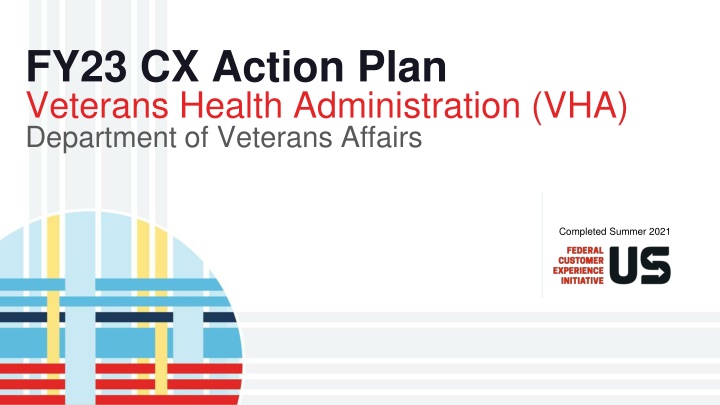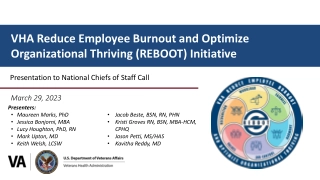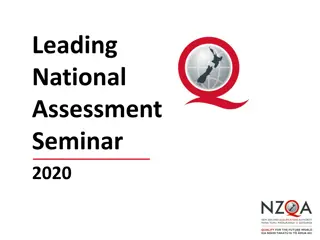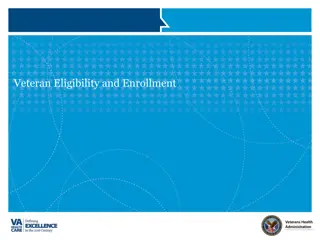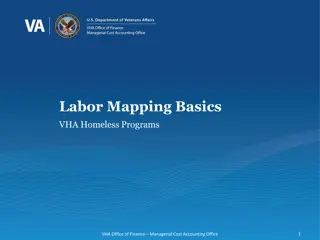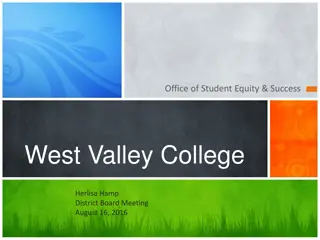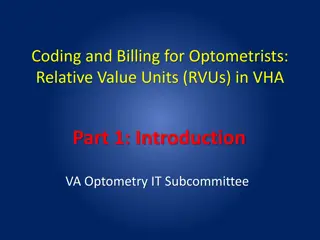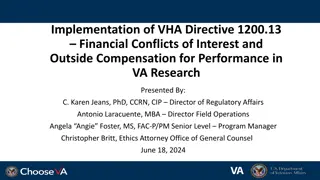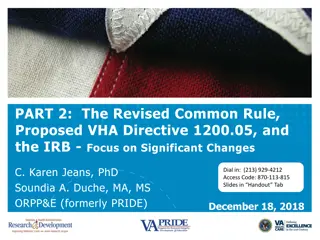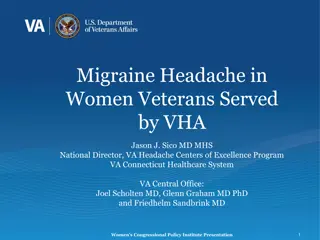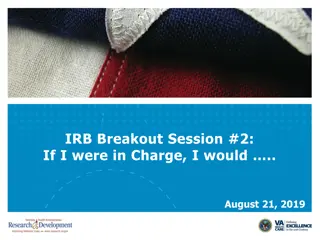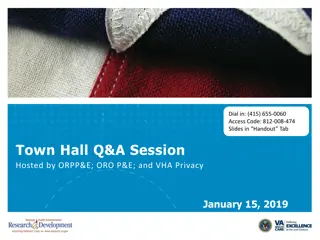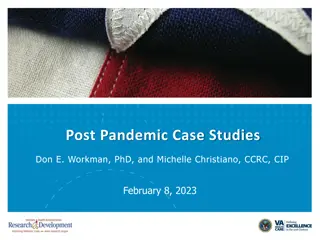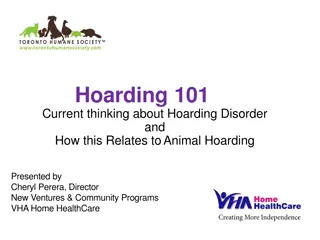VHA Healthcare Innovation & Equity Efforts
Veterans Health Administration (VHA) has successfully implemented a comprehensive five-year plan focusing on patient experience and innovation, especially during the global pandemic. The VHA is dedicated to providing exceptional healthcare services to underserved populations, including veterans facing barriers to access.
Download Presentation

Please find below an Image/Link to download the presentation.
The content on the website is provided AS IS for your information and personal use only. It may not be sold, licensed, or shared on other websites without obtaining consent from the author.If you encounter any issues during the download, it is possible that the publisher has removed the file from their server.
You are allowed to download the files provided on this website for personal or commercial use, subject to the condition that they are used lawfully. All files are the property of their respective owners.
The content on the website is provided AS IS for your information and personal use only. It may not be sold, licensed, or shared on other websites without obtaining consent from the author.
E N D
Presentation Transcript
FY23 CX Action Plan Veterans Health Administration (VHA) Department of Veterans Affairs Completed Summer 2021
FY21 Capacity Assessment Reflection Summary What we re proud of this year: VHA has approved a five-year enterprise-wide plan for Patient Experience that will act as the strategic blueprint for all patient experience (and more broadly most customer experience) work in VHA. This plan was developed by VHA s Patient Experience Committee which governs and oversees all VHA enterprise-wide customer experience work. This plan is aligned with VA s Employee Experience Five Year Enterprise-Wide Plan. The VHA Patient Experience Enterprise-Wide Plan states that VHA s Patient Experience Mission is to promote a culture where every Veteran receives an exceptional experience which is easy, effective, and emotionally resonate to build trust. VHA s vision is to provide the best patient experience in health care. There are five strategic goals: Culture, Atmosphere, Veterans, Continuous Learning, and Employees. The full 1-page plan is at attached at the end of this slide deck. Where we need to do better: We have several different "Voice of Customer" platforms and due to contracts, legal requirements, and appropriations, VHA can only try to integrate the various platforms. Ideally, VHA would consolidate all these platforms into one Voice of the Customer. Currently, VHA is working to integrate two large systems: VHA s Patient Advocate Tracking System (which is known as PATS R within VHA and already consolidates several different complaint management modalities) and VHA s Veteran Signals survey which is due to occur in early FY22 (perhaps as early as October 1st, 2021). 2
Adapting Service During a Global Pandemic Where we innovated VHA quickly adjusted its health care operations due to Covid-19 by massively increasing the usage of telehealth and transitioning as many in-person visits to virtual visits as clinically possible. For example, while VA had conducted roughly 294,000 telehealth visits to patients homes or other non-VA locations in FY2019; in June 2020 alone, the number of such visits grew to 592,608. In the first 10 months of FY2020 from October 2019 through July 2020 more than 700,000 VA patients received at least one real-time (synchronous) telehealth visit to their home or another non-VA location. This is more than seven times the number of patients seen through Synchronous Telehealth in all of FY2019. From March 1, 2020 to July 24, 2021, VHA has seen a 1,443% increase in home or of-site telehealth visits. 3
HISP Equity Reflection Who is this provider intended to serve? America s Veterans including Veterans from underserved populations who make up a significant proportion of current Veterans and an even larger share of future Veterans (current service members). Are there barriers that people of color, people with disabilities, LGBTQ+ people, women, non-native English speakers, and others who have been historically underserved, marginalized, discriminated, and adversely affected by persistent poverty and inequality face with regard to this program or service? How might these individuals interact with your program differently? Yes, there are barriers that underserved Veterans face with regard to accessing and utilizing VHA s healthcare services. VHA is undergoing a large human centered design research effort to better understand these barriers. Underserved Veterans may have more difficulty just accessing and navigating the healthcare services they earned through their military service. This research has and will continue to inform VHA s equity assessment. 4 Where do we have a knowledge gap about individuals interactions with our service we need evidence to fill? Currently VHA (and VA) is in the midst of a large human centered design research effort to determine that knowledge gap about individuals interactions with our health care services and how might VHA minimize that knowledge gap.
FY22 Action Update: Deploy Inpatient Discharge Tools What customer need will this action address? Our FY21 Action Plan identified three inpatient discharge tools to deploy based on a joint human centered design research project between VHA and Veterans Experience Office. These three tools were: Caregiver Support Guide; Journey to Discharge Booklet; and Discharge Checklist. When Veterans hear the word discharge, they expect to leave ASAP, and Discharge instructions are not always well-understood. A good hospitalization experience, followed by a poor facility departure, can damage a Veteran s entire experience. Furthermore, Veterans feel overwhelmed with all the information. How am I possibly going to remember this at home. 41 million family caregivers in the United States provided an estimated 34 billion hours of care to an adult with limitations in daily activities. Building trust with caregivers and improving communication about available services may increase trust with the VA. Consequently, Veterans who are inpatients and their families and caregivers are the customers for the inpatient discharge tools. 5
FY22 Action Update: Deploy Inpatient Discharge Tools Why is this a priority? Through a human-centered design approach, Veterans Health Administration and Veterans Experience Office worked together to develop journey maps of both inpatient hospitalization and discharge journeys of Veterans. These journey maps identified key customer steps, moments that matter, bright spots, and pain points. Then, several inpatient solutions and an inpatient Veterans Signals survey were developed. The research and design team included subject matter experts in inpatient medicine, nursing, hospital administration, human-centered design, statistics & analytics, graphic design, patient experience, and healthcare research. Furthermore, VHA s main customer experience comparison to the greater health care industry is through the HCAHPS (Hospital Consumer Assessment of Healthcare Providers and Systems) survey which asks several discharge related questions. Who is responsible for this action happening? Veterans Health Administration and Veterans Experience Office. 6 What action(s) / deliverables / milestones will you take / hit between Oct. 1, 21 Sept. 30, 22? Deployment of these tools was completed earlier than anticipated in FY21. Our actions now involve sustaining these tools through our consultation team.
FY22 Action Update: Deploy Inpatient Discharge Tools How will you measure whether these actions had their intended effect? VHA will measure implementation of these tools by conducting a bi-annual environmental scan of all VHA health care systems to ask whether that health care system has implemented these tools (it is voluntary not mandatory to use these tools). There are several quantitative questions in both the HCAHPS (Hospital Consumer Assessment of Healthcare Providers and Systems) survey and Veterans Signals Inpatient Survey that test the effectiveness of these tools: Veterans Signals Inpatient Survey Question: When I was notified that I would be leaving the hospital, it was clear what needed to be done and how much time it would take. HCAHPS Question: During this hospital stay, did doctors, nurses or other hospital staff talk with you about whether you would have the help you needed when you left the hospital? Veterans Signals Inpatient Survey Question: Efforts are made to have my family, friends, or caregivers involved in the explanation of my discharge instructions when desired. Veterans Signals Inpatient Survey Question: The instructions I received before I left the hospital were easy to understand. HCAHPS Question: When I left the hospital, I had a good understanding of the things I was responsible for in managing my health. HCAHPS Question: When I left the hospital, I clearly understood the purpose for taking each of my medications. 7 What do you need to make this happen? All things needed such as the surveys, tools, training (virtual), and environmental scan are already in place.
FY22-23 Commit to Action: Veteran Signals Governance and Transformation What customer need will this action address? VHA has launched dozens of Veterans Signals surveys over the past four years with more being developed to continue to measure the many customer journeys that Veterans have navigating VHA s care and service. However, there is no approving mechanism for these surveys and there are concerns that VHA s field-based staff may become overburdened with the vast amount of survey responses as VHA continues to deploy more and more surveys. Furthermore, VHA would like to update its Veteran Signals survey capabilities to better match other health care survey instruments. Finally, VHA would like to provide additional improvement and consultative services to help VHA medical facilities and enterprise- wide respond to survey results. Why is this a priority? VHA is currently trying to review and follow up with hundreds of thousands of survey responses every quarter across various survey instruments including Veteran Signals with more and more surveys being deployed. VHA has three goals over the next two years: develop governance around Veteran Signals, update and transform Veteran Signals, and improve consultative and improvement support to respond to survey responses. 8 Who is responsible for this action happening? VHA and Veterans Experience Office
FY22-23 Commit to Action: Veteran Signals Governance and Transformation What action(s) / deliverables / milestones will you take / hit between Oct. 1, 21 Sept. 30, 22? Work will begin on two of our three efforts regarding Veteran Signals Governance and Transformation with an expected completion date of end of FY22: To provide additional improvement and consultative services to help VHA medical facilities and enterprise- wide respond to survey results Develop a subcommittee that reports to VHA Patient Experience Committee that will oversee Veteran Signals surveys in VHA and approve modifications to existing Veteran Signals surveys and new Veteran Signals surveys 9 What action(s) / deliverables / milestones will you take / hit between Oct. 1, 22 Sept. 30, 23? VHA hopes to complete its third effort to update its Veteran Signals survey capabilities to better match other health care survey instruments by end of FY23.
FY22-23 Commit to Action: Veteran Signals Governance and Transformation How will you measure whether these actions had their intended effect? VHA will review any changes and actions with appropriate stakeholders and senior leaders to ensure they have the intended effect. What do you need to make this happen? The only major challenge is that VA s contract for Veteran Signals may be difficult to modify to update some of the survey capabilities; hence, VHA is shooting to make changes by end of FY23. 10
FY23 Commit to Action: Service Recovery What customer need will this action address? By improving enterprise-wide approach to service recovery, VHA aims to improve customer and patient satisfaction and experiences. VA and the Veterans Experience Office have developed a new VA-wide directive and stood up a VA-wide Service Recovery Workgroup. VHA will implement the VA directive and will implement additional tools to support this enterprise effort. Why is this a priority? Complaint management and improved service recovery are vital to improving the customer experiences across VHA s health care and service offerings. Who is responsible for this action happening? Veterans Health Administration and Veterans Experience Office 11
FY23 Commit to Action: Service Recovery What action(s) / deliverables / milestones will you take / hit between Oct. 1, 22 Sept. 30, 23? By end FY23, VHA aims to have implemented service recovery tools to support VA-wide efforts to improve service recovery. How will you measure whether these actions had their intended effect? Various survey instruments including Veteran Signals and CAHPS (Consumer Assessment of Healthcare Providers and Systems) surveys capture service recovery feedback. In addition, VHA tracks all customer contacts with field-based patient advocates through the Patient Advocate Tracking System. 12 What do you need to make this happen? VHA and Veterans Experience Office will work together to develop a service recovery guidebook and various tools through the human centered research and design process over the next two years.
Appendix 1 VHA PX Enterprise-Wide Plan 13
Commitments from Executive Order 14058 On December 13th, 2021 (after agencies originally developed these action plans as part of the FY23 budget formulation process), President Biden signed Executive Order 14058 on Transforming Federal Customer Experience and Service Delivery To Rebuild Trust in Government. Section 4 of this Order was developed by working with HISPs to identify specific improvements to their core services (many of which were proposed in their FY23 Action Plans), to lift up and energize their existing efforts, improving accountability and support. For VA, EO 14058 commitments include: Provide digital services through a single, integrated, and equitable digital platform on VA.gov and the VA mobile app Provide on-demand customer support through the channels that work best for customers, including personalized online chat with a virtual or live agent. For more updates on agency progress on specific commitments, please visit https://www.performance.gov/cx/executive-order/.
